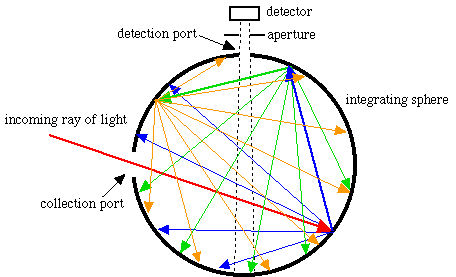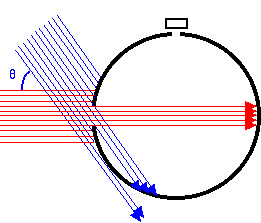
© 1998 Steven L. Jacques, Scott A. Prahl
Oregon Graduate Institute

| ECE532 Biomedical Optics © 1998 Steven L. Jacques, Scott A. Prahl Oregon Graduate Institute |
An aperture is essentially a hole through which light can pass to reach some detection system.
The collection port of an integrating sphere is an aperture.
An integrating sphere is a hollow sphere whose inner surface is coated with a diffusely reflecting material such as barium oxide (eg., as a spray paint available from Kodak Inc., NY), or some plastic (eg., Spectralon from LabSphere Inc., NH).

When a ray of light (red arrow) enters the sphere from any direction, it strikes the inner wall and is reflected diffusely as a diffuse Lambertian source (red arrow is reflected as blue arrows). Each of these reflected rays is again reflected by the wall (one of the blue arrows is reflected as green arrows), and again (one of the green arrows is reflected as ochre arrows), etc. Very quickly the light is randomized within the sphere. A detector collects light from a limited solid angle as it views the opposite wall through the detector port and through an aperture. Hence, the detector "samples" the light within the sphere regardless of how the light entered the sphere. (See a discussion of how to calibrate an integrating sphere).

If a narrow laser beam enters the sphere, it does not matter from which direction the laser beam enters. The entire laser beam power will be collected and the detector will give the same reading.

If a broad beam of uniform irradiance strikes the sphere collection port, the cross-sectional area of the port will allow power to enter the port. The cross-sectional area is weighted by a cosθ term where θ is the angle of entry relative to the normal to the port.
next | Collection | Radiometry